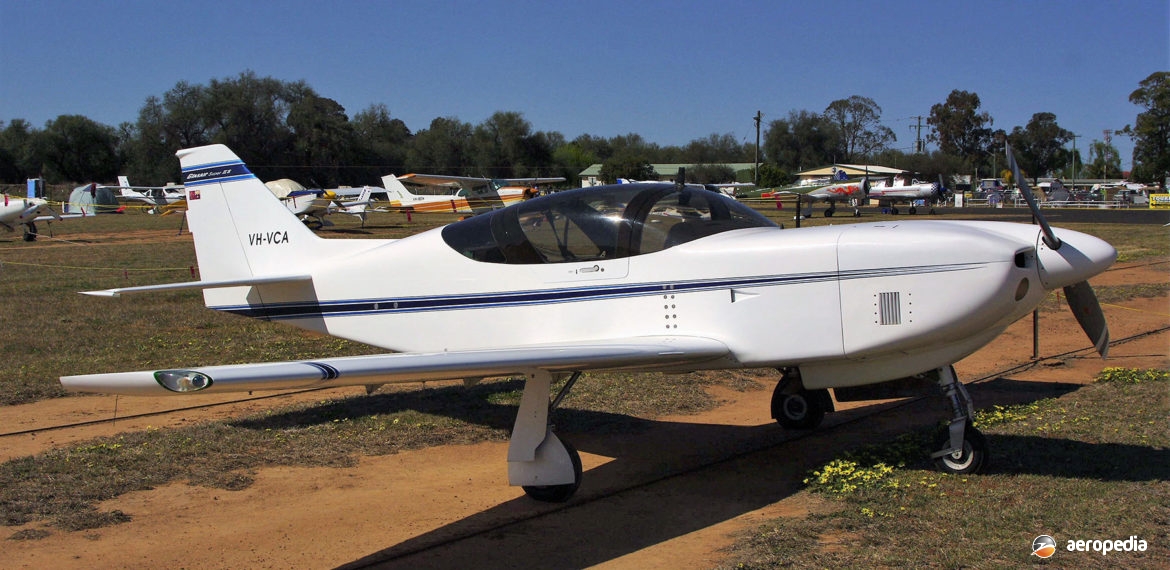Photograph:
Stoddard Hamilton Glasair GII-RG VH-VCA (c/n Q185) at Narromine, NSW in September 2012 (David C Eyre)
Country of origin:
United States of America
Description:
Two-seat light sport monoplane
Power Plant:
(Glasair II TD)
One 112 kw (150 hp) Avco-Lycoming O-320 four-cylinder horizontally-opposed air-cooled engine
Specifications:
- Wingspan: 7.09 m (23 ft 3 in)
- Length: 5.66 m (18 ft 7 in)
- Height: 2.18 m (7 ft 2 in)
- Wing area: 7.54 m² (81.25 sq ft)
- Max speed at sea level: 362 km/h (225 mph)
- Max cruising speed at sea level: 323 km/h (201 mph)
- Stalling speed flaps down: 94 km/h (58 mph)
- Max rate of climb at sea level: 518 m/min (1,700 ft/min)
- Service ceiling: 6,100 m (20,000 ft)
- Max range with max fuel at 50% power cruise: 1,609 km (1,000 miles)
- Empty weight: 420 kg (925 lb)
- Loaded weight: 680 kg (1,500 lb)
History:
Thomas Stoddard commenced development of a light aircraft in 1975 and set up a facility at the Cedar Grove Airport in Seattle. By 1977 he had built his first two-seat tandem design known as the Pocket Rocket. However, it suffered some shortcomings and was retired. He went on to design the Glasair, originally designated SH-2, the prototype of the series (N88TH) being flown for the first time in 1979 after four years of development. This aircraft was powered by an 86 kw (115 hp) Avco-Lycoming O-235 engine and was followed by a second aircraft (N89SH) which had a 112 kw (150 hp) Avco-Lycoming O-320 engine installed.
This second prototype was completed in 1980 and incorporated a taller canopy. Subsequently the Glasair became one of the most popular homebuilts in the world, with many hundreds being constructed in a variety of models, and using a number of engine types. The first two models were known as the ‘TD’ and the ‘RE’, the prototype of the latter (N87SH) being flown for the first time on 13 July 1982. Whereas earlier machines had a fixed undercarriage, it differed in having a retractable undercarriage and, when fitted with a 134 kw (180 hp) Lycoming IO-360 engine, was able at 2,440 m (8,000 ft) to max cruise at 389 km/h (242 mph).
The wing was of tapered cantilever section of one-piece composite construction with continuous main spar of moulded fibreglass. The fuselage also was of composite construction, made in two half-shells and a belly panel, with a firewall and only two bulkheads. Baggage capacity was 36 kg (80 lb).
First of the type completed in this region was a GII-S-FD VH-OOO (c/n N115), first registered in 1984. Since then the type has become very popular with more than 40 completed in Australia and four in New Zealand. Overseas, engines up to over 261 kw (350 hp) have been fitted to provide high performance; some have been built as high-speed transports with glass-cockpits; some have fixed tailwheel undercarriages, others fixed tricycle undercarriages, or retractable underarriages. At least one example has been fitted with a 540 kw (750 hp) Czech Walter 601 turboprop engine, this aircraft climbing at 3,048 m/min (10,000 ft/min) and achieving a top speed of 483 km/h (300 mph).
The Glasair was marketed by Stoddard Hamilton Aircraft Inc of Arlington, Washington DC, in Virginia for many years but had some financial problems and a consortium rescued the Company. Models available have included the Super IITD with a tailwheel and engines in the 112 kw (150 hp) to 149 kw (200 hp) range; Glasair Super IIFT, a similar aircraft with a tricycle undercarriage; Glasair Super IIRG, a retractable undercarriage model of the previous two; Glasair III with engines in the 186 kw (250 hp) to 224 kw (300 hp) range and a retractable tricycle undercarriage; Glasair III Turbo with a Lycoming TIO-540 turbocharged engine and retractable tricycle undercarriage; and the Turbine 250/III, a variant of the Glasair III designed in 1994 and fitted with an Allison 250 turbine that provided a max speed of 531 km/h (330 mph).
This latter model made its debut at Oshkosh, Wisconsin and had a lengthened wingspan and ailerons, wet wings holding 326 litres (72 Imp gals) of jet fuel, dorsal and ventral fins, and was painted at one stage in US Air Force markings by the constructors, Becktold Aircraft of Washington. In more recent times the type has been marketed by Glasair Aviation. More than 1,200 examples of all models have been completed.
A number of examples of the SH-2 series have been registered in Australia, including: Model SH-11RG :VH-MMI (c/n 587); VH-SII (c/n 2428); VH-CCG (c/n 2070); VH-HUD (c/n 2447); VH-VCA (c/n Q185); VH-LDF (c/n Q084); VH-JBB (c/n Q088); VH-LQP (c/n Q43); VH-OSW (c/n 707RG); VH-MTT (c/n 469); and VH-PCH (c/n 1095). Model S11SFT: VH-MHM (c/n 2460); VH-FLO (c/n 2373); and VH-NEO (c/n 2367). Model S11S: VH-EVA (c/n 2214). Model 11SFT: VH-PND (c/n 2138). Model SH-2FT: VH-NZN (c/n 2011); VH-KMX (c/n 572); VH-JBJ (c/n N248); and VH-THK (c/n N207). Model SH-2TD: VH-OSG (c/n 184); VH-MYY (c/n 326); and VH-HRG (c/n W121). Model 11S-FT: VH-AYE (c/n V258) and Model SH-2R: VH-AHU (c/n 383).

